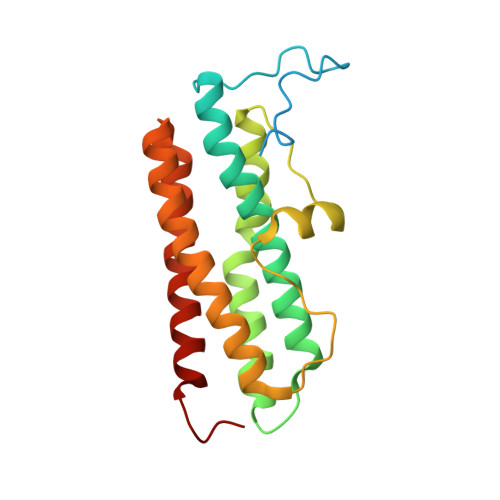Crystal structure of Dps-1, a functionally distinct Dps protein from Deinococcus radiodurans.
Kim, S.G., Bhattacharyya, G., Grove, A., Lee, Y.H.(2006) J Mol Biol 361: 105-114
- PubMed: 16828801
- DOI: https://doi.org/10.1016/j.jmb.2006.06.010
- Primary Citation of Related Structures:
2F7N - PubMed Abstract:
DNA protection during starvation (Dps) proteins play an important role in protecting cellular macromolecules from damage by reactive oxygen species (ROS). Unlike most orthologs that protect DNA by a combination of DNA binding and prevention of hydroxyl radical formation by ferroxidation and sequestration of iron, Dps-1 from the radiation-resistant Deinococcus radiodurans fails to protect DNA from hydroxyl radical-mediated cleavage through a mechanism inferred to involve continuous release of iron from the protein core. To address the structural basis for this unusual release of Fe(2+), the crystal structure of D. radiodurans Dps-1 was determined to 2.0 Angstroms resolution. Two of four strong anomalous signals per protein subunit correspond to metal-binding sites within an iron-uptake channel and a ferroxidase site, common features related to the canonical functions of Dps homologs. Similar to Lactobacillus lactis Dps, a metal-binding site is found at the N-terminal region. Unlike other metal sites, this site is located at the base of an N-terminal coil on the outer surface of the dodecameric protein sphere and does not involve symmetric association of protein subunits. Intriguingly, a unique channel-like structure is seen featuring a fourth metal coordination site that results from 3-fold symmetrical association of protein subunits through alpha2 helices. The presence of this metal-binding site suggests that it may define an iron-exit channel responsible for the continuous release of iron from the protein core. This interpretation is supported by substitution of residues involved in this ion coordination and the observation that the resultant mutant protein exhibits significantly attenuated iron release. Therefore, we propose that D. radiodurans Dps-1 has a distinct iron-exit channel.
Organizational Affiliation:
Department of Biological Sciences, Louisiana State University, Baton Rouge, 70803, USA.
















